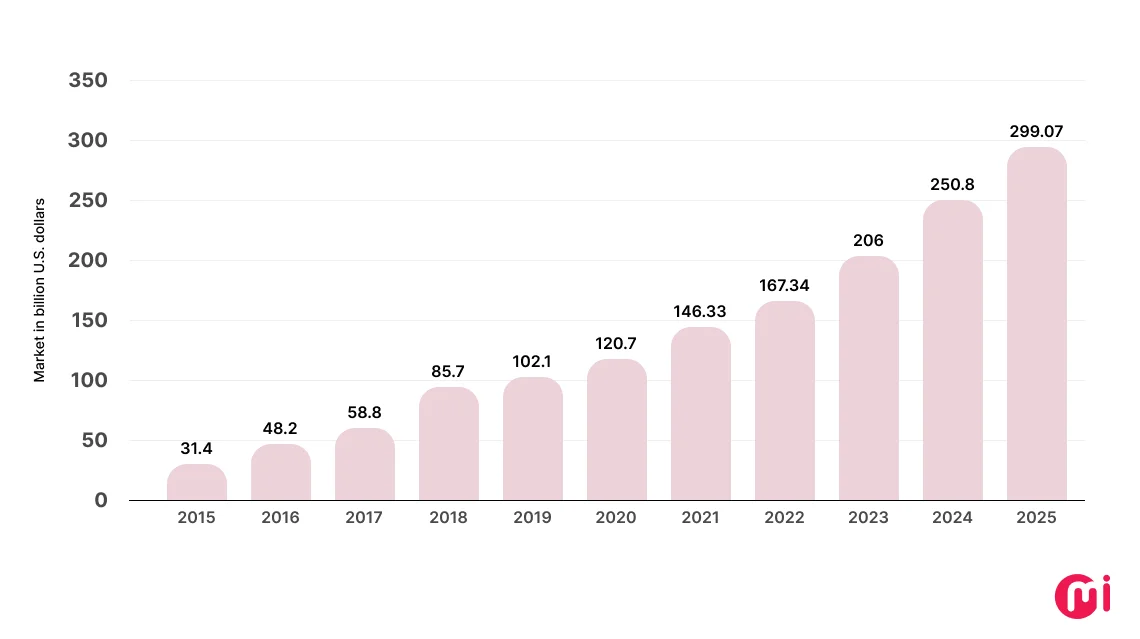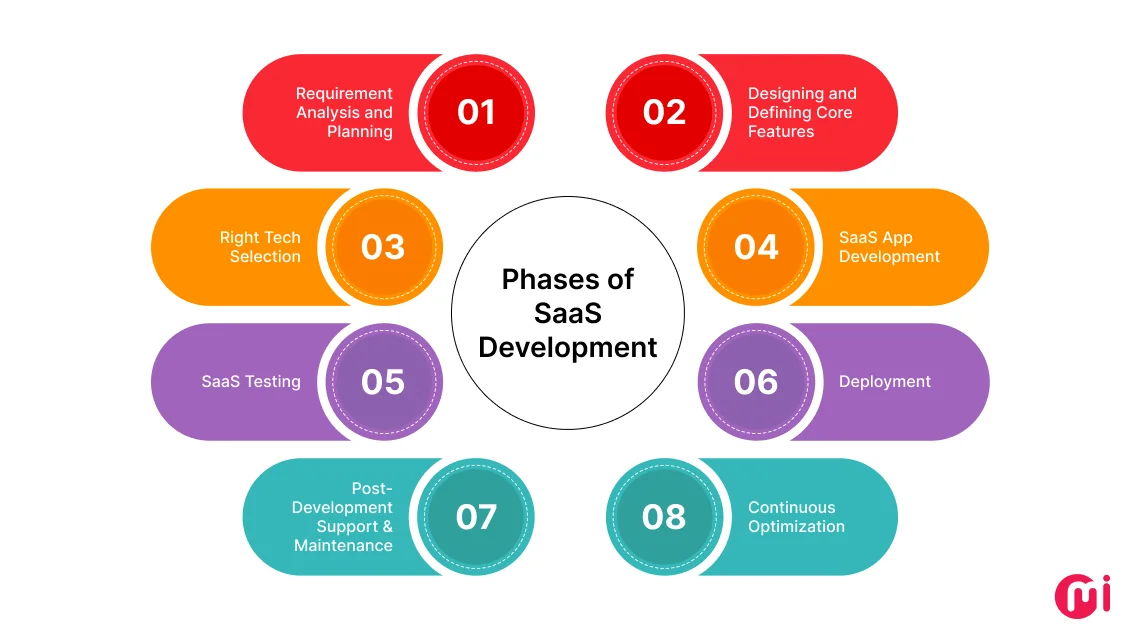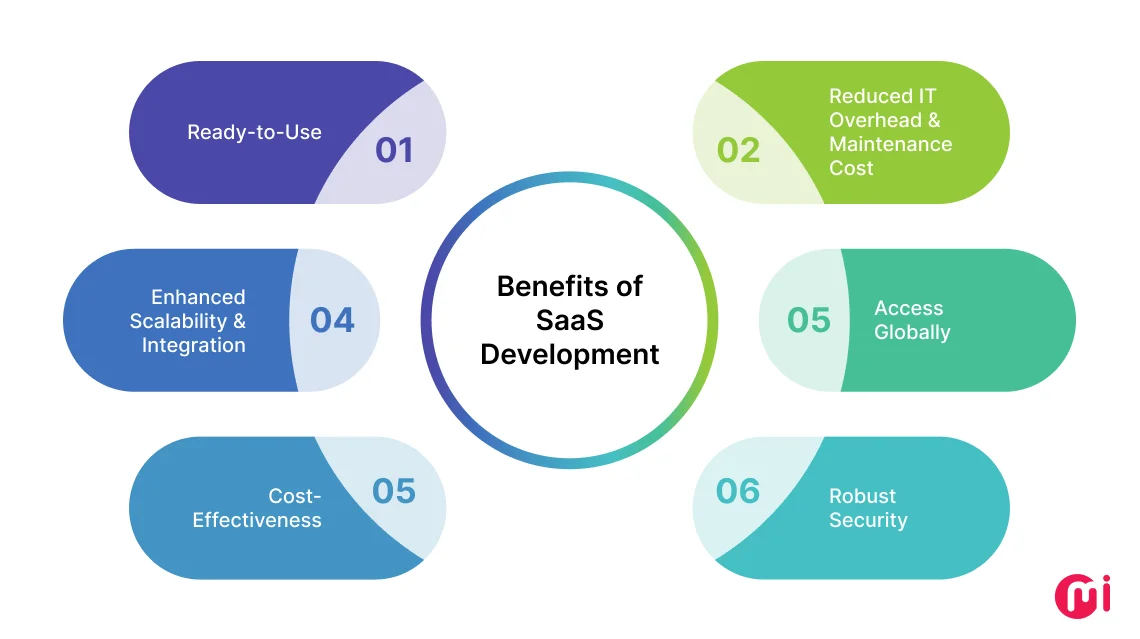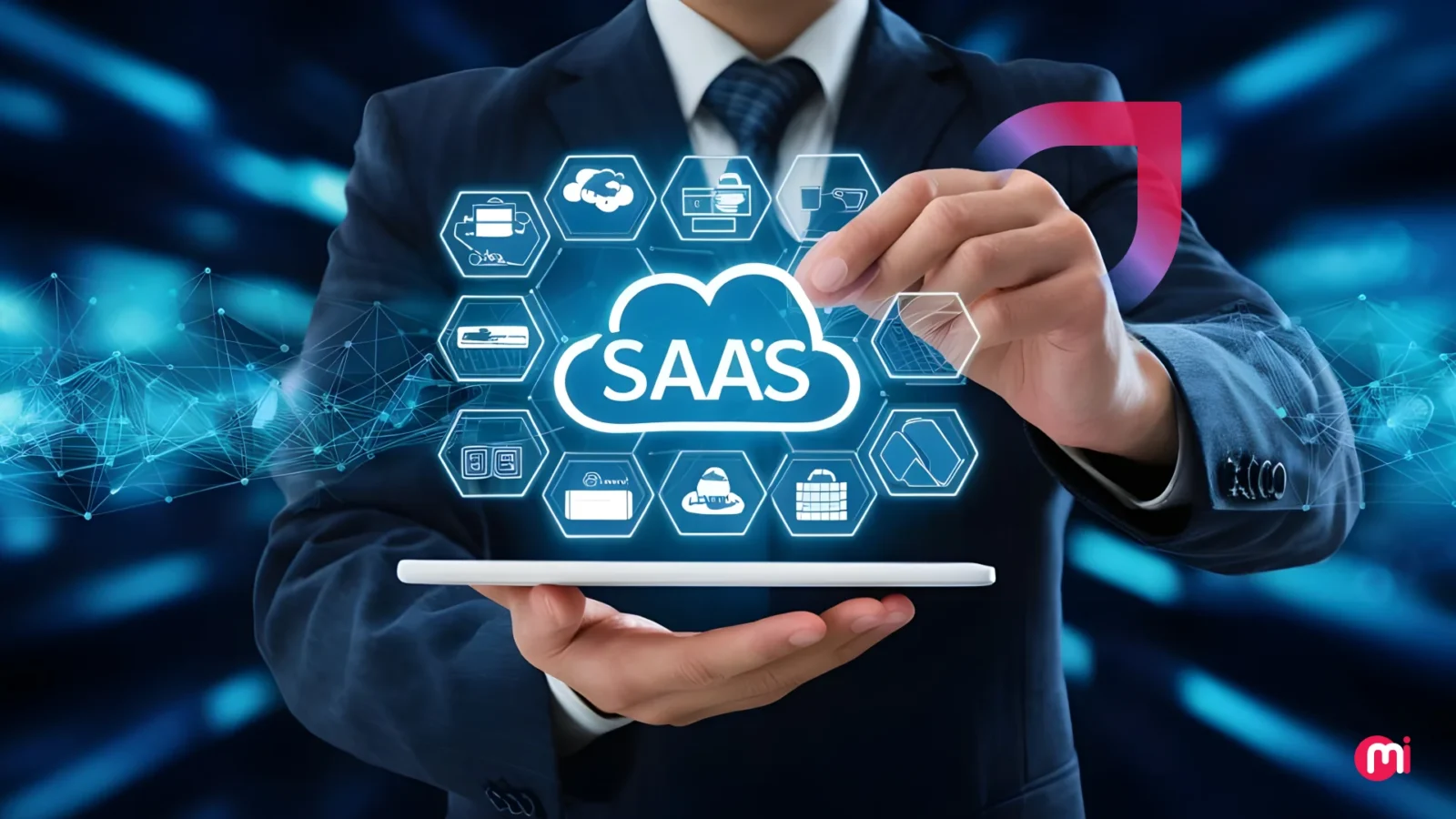SaaS development refers to designing and developing cloud-hosted software that can be accessed by users of different types from anywhere. This SaaS development guide contains everything SaaS founders need to know about SaaS development. It includes what’s SaaS? types of SaaS, the importance of SaaS for today’s business, the role of SaaS founders, phases of SaaS development, features, and real-life examples of SaaS solutions. This guide includes the cost of SaaS development, too, enabling startup founders to navigate through a convenient SaaS development journey.
Did you know that the SaaS market is estimated to reach around $300 billion by 2025? Yes, and that level of growth is attributed to the high-end business-centric offerings of SaaS solutions. Right from analytics and reporting to simplifying user management and subscription management with precision, SaaS solutions feature the next level of offerings, easing how businesses operate in this digital era.
Slack, Salesforce, Shopify, Netflix, Dropbox, and Google Workspace are among many SaaS solutions, contributing to the huge popularity and growth of the SaaS marketplace. If you are planning SaaS development, knowing everything beforehand is crucial. It’ll help you build a full-fledged SaaS product that allows businesses to operate smoothly.


As a SaaS founder, you need to have intensive know-how on how to build a feature-rich, well-functioning SaaS solution that caters to the unique needs of businesses so that you can easily succeed in your project. This SaaS development guide will navigate you through end-to-end information about SaaS software development, easing your project development initiative.
What Is SaaS Application Development?
Software as a Service (SaaS) is a software licensing and delivery model of a cloud-hosted solution. Hosted and managed by a third-party service provider, SaaS solutions are accessible for users over the internet with a license on a subscription model. Users can access these solutions irrespective of wherever they are with no need to install the application.
SaaS application development is the process of designing, developing, and delivering a software product that aims to provide solutions to specific issues of targeted customers. It allows easy access to the software without a major initial investment, as users can avail of it on a pay-as-you-go or subscription model.
Types of SaaS Applications
Here are a few types of SaaS applications with real-life examples that will give you a crystal clear understanding of the same:
1. Enterprise Resource Planning (ERP)
ERP systems are types of software that allow businesses to manage and integrate the important elements of their businesses. An ERP integrates core business processes in real-time, ensuring streamlined operation and accurate data reporting along with improved decision-making across departments such as HR, finance, manufacturing, supply chain, sales, and many more.
Delivered as a SaaS solution, they provide enterprises with the flexibility to customize the system as per their requirements. With the pay-as-you-go model, organizations can select the necessary modules to manage different aspects of their operations, like supply, chain inventory manufacturing, and the like.
Real-Life Example of ERP
- SAP: SAP is one of the most popular ERP software providers, offering its solution to a wide variety of large enterprises. With modules like SAP Financial Accounting (FI), SAP Human Resources (HR), and SAP Supply Chain Management (SCM), SAP eases finance, HR, and sales across organizations.
- Oracle ERP Cloud: Oracle ERP Cloud is a cloud-based ERP solution for procurement, project, and finance management. It is popularly used by both mid-sized and large enterprises to accelerate their back-office processes.
2. Customer Relationship Management (CRM)
SaaS solutions for CRM such as Salesforce and HubSpot CRM enable organizations to manage and streamline customer interactions, keep track of sales, and improve customer relationships with ease and convenience. These systems come embedded with features to manage contracts, track leads, and automate sales while assessing customer data for informed decision-making.
Real-Life Example of CRM
- Salesforce: It provides cloud-based CRM tools to manage customer data and sales and manage marketing analysis and automation effectively.
- HubSpot CRM: It’s a free-to-use CRM tool that features email marketing, lead management, sales tracking, and more. The features of free HubSpot CRM include live chat, dynamic lists, up to 1000 contracts, forms for lead capture, and email marketing.
3. Project Management & Collaboration Tools
These types of SaaS software solutions focus on elevating collaboration and productivity among team members. Trello and Asana are among the top solutions that allow teams to collaborate, track and manage tasks, and keep track of progress, improving overall workflow efficiency and business profitability.
Real-Life Examples of Project Management and Collaboration Tools
- Trello: Trello is a visual tool aiming for task and project management, making use of boards, lists, and cards.
- Asana: It allows teams to organize, plan, and manage work with proper tracking of tasks, workflow, and deadlines.
4. Human Resources (HR) and Payroll Software
Some popular SaaS solutions include BambooHR and Gusto. They automate and simplify various tasks like recruitment, employee onboarding, time tracking, performance management, and payroll management.
Real-Life Examples of Human Resources (HR) and Payroll Software
- BambooHR: An HR software solution that assists businesses with recruitment, employee data management, and performance reviews.
- Gusto: A payroll and HR platform that simplifies tax filing, payroll, and employee benefits for small businesses.
5. Communication and Video Conferencing Tools
SaaS applications like Slack and Zoom provide remote communication and messaging among team members. They feature instant messaging, video conferencing, video calls, file sharing, and collaborative document editing.
Real-Life Examples Communication and Video Conferencing Tools
- Slack: It’s a team communication tool that tends to integrate with different apps and allows for real-time messaging.
- Zoom: It’s a video conferencing platform that provides support for webinars, meetings, and team collaboration.
6. Financial Management and Accounting Software
SaaS solutions like QuickBooks Online and Xero help organizations manage their financial operations such as accounting, invoicing, billing, and bookkeeping. They help companies manage their financial operations in the best way possible, ensuring reduced hassles and enhanced profitability.
Real-Life Examples Financial Management and Accounting Software
- QuickBooks Online: A cloud-based accounting software ensures an efficient handling of payroll, invoicing, and financial reporting.
- Xero: It’s cloud accounting software that provides payroll, invoicing, and financial reporting for robust financial management and accounting in organizations.
Importance of SaaS In Today’s Business Landscape
Software as a Service provides enhanced flexibility, scalability, and cost-effectiveness, making it a must-have for businesses. SaaS companies allow access to the solutions with subscription-based pricing, making it affordable for businesses from various domains and helping them not to worry about huge initial investments.
SaaS solutions allow faster implementation, remote work, and seamless collaboration, boosting innovation and productivity. The robust security measures and automated updates help businesses stay updated with minimalistic efforts. SaaS provides data-driven insights, empowering businesses to stay agile, mitigate overhead, and respond quickly to market change by adopting them seamlessly.
This drives overall growth and competitiveness in businesses. Besides, SaaS is developed and managed by SaaS companies, thereby keeping users free from software maintenance and updates.
With no sign of slowing down, the SaaS market is anticipated to reach around $300 billion by the year 2025. Look at the image below for a clear picture!


Role of Founders In SaaS Development
Founders are bound to play a multifaceted role in SaaS development. Their involvement spans from the vision and strategy to the execution of SaaS development and scaling it down the line. This SaaS development guide also describes the key roles and responsibilities of a SaaS founder in SaaS development:
Setting Mission/Vision & Strategy
A SaaS founder establishes the mission and vision of the SaaS business, guiding the product’s direction and making sure it aligns with the long-term goals. They pinpoint the target market, customers’ pain points, and the issues the SaaS product is going to address. This intense insight helps founders shape the SaaS features and ensure they resonate with the audience’s pain points.
SaaS founders are responsible for creating a product roadmap, defining key features and functionality, and milestones to be developed over time. They prioritize it based on customer feedback, market needs, and technical feasibility.
Fundraising & Financial Management
SaaS businesses often need upfront investment and founders raise capital to fund development. It involves pitching to venture capitalists (VCs), angel investors, or additional sourcing for funding. Besides, they are also responsible for managing the financial aspects of the project, including budget allocation for development, marketing, operations, and scaling. The economic discipline ensures that the SaaS company remains sustainable as it scales down the line.
Many startup founders prefer to opt for SaaS bootstrapping to succeed in their projects.
Team Building & Leadership
SaaS founders are responsible for building and scaling the core team. They do so by hiring SaaS developers and other talent for development, marketing, sales, customer support, and operations. A robust and motivated team contributes hugely to the success of a SaaS business. Founders tend to set the tone for company culture and values, which is crucial for creating a productive, collaborative, and innovative environment.
Product Development & Innovation
In many cases, SaaS founders help the development team determine the initial version of the product, make the key technology choice, and ensure the software is secure and scalable. They participate in creating software development life cycle (SDLC), oversee the product iteration, and make sure it evolves as per the customer’s feedback, market trends, and technological advancements.
They make decisions about new features, integrations, and improvements. The SaaS founder sets the quality standards for the product, implements them, and ensures they are maintained throughout the development.
Focus on End Users
SaaS founders engage directly with customers to understand their pain points and validate the product-market fit. It helps shape the product to the customer’s needs. In SaaS, customer retention is as essential as acquiring a new one; hence, SaaS founders drive customer success strategies intending to improve customer retention, minimize churn rate, and foster long-term relationships.
Sales & Marketing
SaaS founders define the initial go-to-market strategy, which includes deciding on sales channels, pricing models (freemium, subscription-based), and promotional tactics. They often take the lead role in sales like direct sales or partnership-building. The SaaS founder also develops sales strategy and trains the sales team as the business scales to be aligned with the growing needs.
Founders establish the brand’s identity and make sure the product stands out in the marketplace. It might involve creating messages, developing an online presence, and driving thought leadership.
Strategic Partnerships & Networking
Founders tend to be the face of the company at industry events, conferences, and in interaction with the media, establishing the brand as an industry leader. They foster partnerships with other technology service providers, resellers, or influencers that help expand the product’s reach and value propositions.
Scaling & operations
SaaS businesses expand their infrastructure as the business grows, ensuring the software is aligned with the scaling needs of the users. They oversee the operational areas of the product and ensure efficient service, billing, and additional back-end operations.
8 Phases of SaaS Development
Similar to other software development, it takes a step-by-step approach to build a SaaS solution. Having a pre-defined approach has a lot to do with the success of your project. Therefore, explore the 8-step guide on how to build a SaaS app from scratch, which will help you turn your idea into a full-fledged SaaS software solution.


1. Requirement Analysis and Planning
This phase involves conducting thorough research and outlining product requirements to build a product that aligns with users’ expectations. Business analysts (BA) play a crucial role as they conduct intensive research and define the product’s present as well as future scope. They do so by conducting competitor analysis, finding loopholes, and making appropriate improvements to the product.
2. Designing and Defining Core Features
This phase of SaaS development involves designing wireframes, UI/UX, and functional prototype development. The very phrase ascertains and visualizes the overall structure and features of the SaaS product. It keeps developers from wandering in between the project development, fostering excellent software development.
3. Right Tech Selection
Another phase of SaaS development involves smart tech selection. A wise tech selection should be one of the top priorities when it comes to SaaS development. A SaaS development tech stack involves choosing programming languages, frameworks, databases, and cloud platforms. When done righteously, it ensures a successful SaaS development.
4. SaaS App Development
In this phase, the SaaS development takes place and is completed. Solution architects and SaaS developers work hand in hand. While the former takes care of the infrastructure architectures and level designs, the latter writes source code for SaaS solutions utilizing the tech stacks determined in the tech selection phase.
The information and data security personnel also play a role in the development phase, as they assist in implementing the SaaS development best practices associated with governance and security.
5. SaaS Testing
In this phase, the end-to-end app testing takes place. The testers conduct unit testing, integration testing, user acceptance testing, performance testing, and security testing. The integration testing validates the components work seamlessly, while UAT includes functionality testing to make sure the app meets the user’s expectations.
Performance testing aims to test for load balancing, response time under high traffic, and scalability, while security testing ensures the product is free from any vulnerability and complies with regulations and data privacy such as GDPR.
6. Deployment
This phase involves complete SaaS product deployment. The developers deploy the application to the cloud, such as AWS, Azure, Google Cloud, etc. They also conduct continuous integration/continuous deployment (CI/CD), implementing automated pipelines for safer and seamless updates.
The SaaS experts also configure domain names, SSL certificates, and appropriate DNS settings and implement monitoring tools for performance tracking, error reporting, and uptime checks.
7. Post-Development Support & Maintenance
This SaaS development phase includes continuous bug detection and fixing, patching security vulnerabilities, and updating the solution to enhance functionalities. The SaaS experts get continuous feedback from users and identify new issues and requested features to bring them in alignment with the user’s needs.
Besides, they keep monitoring and making adjustments to the infrastructure to handle growing user requirements, ensuring optimized scalability.
8. Continuous Optimization
This phase aims to continuously release new features based on market trends and user needs. Testers perform A/B testing, experimenting with new features and UI changes to measure their impact on user experience. They also use data analytics to identify specific areas of improvement and performance optimization to ensure an optimized user experience.
Key Features of Successful SaaS Solutions with Real-Life Examples
An excellent SaaS solution comes embedded with a multitude of features and functionalities essential to succeed in this competitive marketplace. These features involve user management and authentication, billing & subscription management, data security & privacy, and many more.
Each of these features has a crucial role to play, ensuring the SaaS solution is secure, reliable, and aligns with the user’s needs and preferences. Here are a few of the features of a SaaS solution with real-life examples you would love to know:
1. User Management & Authentication
User management and authentication refer to the feature that enables administrators to manage user access, roles, permissions, and security in a SaaS platform. It involves functions such as login, registration, multi-factor authentication (MFA), password recovery, and role-based access control (RBAC).
Real-World Example: Slack
Slack is a team collaboration tool that enables administrations to manage user roles and permissions, set up Single Sign-On (SSO), and enforce two-factor authentication (2FA). It supports different levels of access, including members, admins, guests, and the like. Admins can control who has access to channels, integrations, and workspaces.
2. Billing & Subscription Management
Billing and subscription management ensures smart handling of payment processing, pricing tiers, invoicing, renewals, and usage tracking. It allows businesses to manage customer subscriptions, automate billing cycles, provide flexible plans, and integrate with payment gateways. The very feature ensures smooth revenue collection and user access control, elevating overall customer experience and retention.
Real-World Example: Netflix
Netflix provides a variety of subscription plans with diverse pricing based on the number of screens and resolutions, including basic, standard, and premium plans. It tends to handle automated billing and usage tracking, like how much content is watched and sends payment receipts for the subscription changes.
3. Data Security & Privacy
Data security and privacy protect user data from breaches, thefts, or unauthorized access. The very feature involves encryption, secure authentication, and compliance with data protection regulations such as HIPAA, DGPR, or CCPA.
Real-World Example: Dropbox
Dropbox protects users’ data with SSL/TLS for data in transit and AES-256 encryption for data at rest. Furthermore, it provides two-factor authentication (2FA), complies with GDPR, and ensures that the user’s personal information is stored and handled with optimal security as per privacy regulations. Dropbox also provides users with tools, allowing them to efficiently manage and delete their sensitive data as needed to align with privacy policies.
4. Collaboration Tools
Collaboration tools in SaaS solutions allow teams to work hand-in-hand, communicate effectively, share documents, and track a project’s progress. The very tools feature file sharing, messaging, document editing, task management, and the like.
Real-World Example: Google Workspace
Formerly known as G Suite, Google Workspace consists of tools such as Gmail, Google Drive, Google Docs, and Google Meet, allowing teams to collaborate and work effectively. Working with this very tool, multiple users can edit documents simultaneously, schedule and conduct video meetings, share files securely, and manage calendars. It allows integration with additional tools for smooth collaboration among teams working in different locations.
5. Scalability & Performance
Scalability and performance are all about the ability of a SaaS solution to handle an increasing amount of data, a growing number of users, and requests with no performance degradation. This feature includes efficient use of resources to scale vertically (adding power to servers) or horizontally (adding more servers or instances).
Real-World Example: Shopify
Shopify is an eCommerce platform that offers optimal scalability for businesses of different sizes. It makes use of cloud infrastructure like Google Cloud, AWS, and the like to scale its services automatically and make sure the website is fast and responsive under changing load levels. Be it a small startup or a global brand, Shopify can competently handle huge amounts of traffic during peak times.
6. Analytics & Reporting
SaaS solutions feature analytics and reporting, providing invaluable insights into system performance, user behavior, and business metrics. The feature involves dashboards, data visualization, automated reporting, and assisting businesses to keep track of customer engagement, use revenue, and many other KPIs.
Real-World Example: HubSpot
HubSpot, a CRM and marketing automation platform, offers highly responsive analytics and reporting tools. It allows businesses to track the real-time performance of different aspects like marketing campaigns, customer interactions, and sales activities. HubSpot’s dashboards display key metrics such as website traffic, email open rates, lead conversions, and so on, assisting businesses to optimize their strategies by leveraging these data-driven insights.
7. Customization & Personalization
Customization and personalization are excellent features of SaaS solutions that allow users to tailor this platform according to their needs. It includes customizing, branding, workflows, user interfaces, and the like. Personalization of SaaS solutions can also extend to content or functionality depending on the user’s behavior and preferences.
Real-World Example: Salesforce
Making adjustments to the site’s theme, setting up the target audience, and downloading AppExchange solutions, Salesforce provides extensive customization alternatives to users. It allows users to tailor their CRM with custom fields, dashboards, workflows, reports, and so on.
Benefits of SaaS Development
The high-end features of SaaS bring immense benefits to the table for both users and founders. Mentioned below are among the top benefits of SaaS to name a few:


1. Ready-to-Use
Unlike traditional models, the SaaS is already developed, installed, and configured, thereby, ready to use for users. Users just need to provision the server like in the cloud and use the system in just a matter of a few hours. It lessens the time spent on installation and configuration and limits issues in software development and deployment.
2. Reduced IT Overhead & Maintenance Cost
A SaaS is developed and maintained by a service provider, freeing users from investing immensely in development and maintenance. SaaS providers push updates and patches from a central server, eliminating the need for customers to manage complex installations and updates. It limits the cost associated with customer support and manual intervention.
3. Enhanced Scalability & Integration
In general, SaaS solutions reside in cloud environments, which are scalable and integrate with other SaaS offerings. What’s more, you have the flexibility to scale your SaaS use up and down based on specific needs.
4. Access Globally
With cloud-based distribution, SaaS products can be accessed from anywhere, allowing SaaS founders to extend their reach to the global market with no need for physical infrastructure or extensive operational adjustment. It elevates the business’s market potential exponentially.
5. Cost-Effectiveness
SaaS typically resides in a shared or multi-tenant environment where the software and hardware license cost is lower than that with the traditional model. SaaS allows small and medium businesses to employ software that they otherwise would not utilize because of higher licensing costs. Besides, SaaS also frees users from bearing maintenance costs and efforts, as it’s taken care of by the service provider.
6. Robust Security
SaaS comes embedded with robust security measures through encryption (both in transit and at rest), role-based access control, multi-factor authentication, continuous monitoring, vulnerability scanning, and compliance with industry standards such as SOC 2 and GDPR. Continuous penetration testing, secure APIs, and incident response plans further safeguard data and maintain system integrity.
Common Challenges and Pitfalls in SaaS Development for Founders
Although SaaS provides many pros, building the same comes with a few challenges. Look at the following SaaS development challenges so that you can be familiar with and tackle them with ease:
Product-Market Fit
Startup founders often seem to be struggling when creating a product that completely resonates with their target market. Misunderstanding the user’s needs, overcomplicating features, or failing to validate the product early may lead to a lack of product-market fit. It could be because of rushing development without testing or failing to adopt based on customer feedback.
Scalability
Developing a SaaS that scales as per the customer base is one of the challenges of SaaS development. Issues such as poor architecture design, lack of cloud infrastructure planning, or underestimating support requirements may lead to performance degradation or operational inefficiencies.
Aligning User Expectations
Setting realistic expectations for users is challenging. Aggressive promises for a feature-rich product can lead to disappointments, affecting the reputation and customer’s trust.
Reliability
Reliability could be one of the SaaS development challenges. SaaS founders can ensure it by selecting reliable programming languages, databases, servers, and cloud infrastructure.
Monetization
Founders often come across dilemmas when determining how to make money out of SaaS solutions. Choosing a suitable SaaS pricing model and strategy is essential.
Security & Compliance
SaaS platforms are targeted by cybercriminals. Hence, ensuring robust security measures and complying with data protection regulations like GDPR is crucial.
Customer Acquisition & Retention
Generating leads and converting them into long-term paying clients is essential but challenging as well. SaaS businesses thrive most on long-term customer relationships rather than just acquiring new ones.
Success Tips for SaaS Founders
All the above are needed; however, as a SaaS founder, to succeed in this highly competitive marketplace, you need to implement effective strategies. Following are the success tips for SaaS founders, enabling them to embrace optimized success for their projects.
Be Unique
For a SaaS startup to succeed, being unique in some way is essential. A startup should ensure its product is unique and caters to the business needs of users excellently. Dropbox, for instance, is a successful SaaS startup because of its unique value proposition. It offers simple, and reliable cloud storage with convenient file synchronization across devices.
It resolves common issues of data access and sharing. Besides, an intuitive interface and seamless user experience led to accelerated adoption and growth of the very SaaS solution.
Go to Market ASAP
Don’t wait too long to enter the marketplace. Ensure you launch your unique product on the market ASAP. Salesforce is an excellent example of a successful SaaS development because of its early arrival to the market.
As one of the first cloud-based Customer Relationship Management (CRM) platforms, Salesforce provided subscription-based, scalable solutions and thereby disrupted the traditional software model. This early market entry enabled it to capture a huge chunk of its customer base, establishing itself as a leader in the marketplace.
Measure Conversion Rate Continuously
Creating and employing marketing strategies is essential; however, the consistent measurement of conversion rate is essential. HubSpot is a great example of a successful SaaS startup that embraced success because of its uninterrupted measurements of conversion rate. Considering data-driven marketing and sales strategies, HubSpot continuously optimized its customer acquisition funnel.
It meticulously kept track of conversion rates across channels, enhancing landing pages, offers, and customer engagement, intending to drive growth and innovation. That level of focus on metrics assisted HubSpot to fine tune inbound marketing tools, leading to its elevated adoption and success in the marketplace.
Choose to Bootstrap Over Seeking Fundings
Founders can choose to find investors; however, considering SaaS bootstrapping can be an excellent idea to thrive a SaaS startup. With bootstrapping, startups can thrive with no risk and interventions from outside investors.
Basecamp is an excellent example of a SaaS startup that succeeded through bootstrapping. Founded by Carlos Segura, Jason Fried, and Ernest Kim, Basecamp developed its project management software without funding from outside. The founders focused more on sustainable growth by prioritizing customer satisfaction and profitability over rapid scaling.
This bootstrapped approach enabled Basecamp to retain complete control of its business, leading to a durable and stable success and a loyal customer base.
Be User-Friendly for Customer Success
Being user-friendly and striving for customer success is the key. The majority of successful SaaS solutions out there are those that focus more on providing user-friendly solutions. Therefore, make sure to be there at your customer’s service to help them tailor the solution accordingly.
Zendesk is a successful SaaS startup because of its user-friendly design and offerings. By offering an intuitive, easy-to-use ticketing and tailored support platform, zendesk allows businesses of different sizes to accelerate customer service operations. Its simplicity, combined with high-end features such as multi-channel support, assisted in driving to the next level of customer satisfaction and retention, contributing to Zendesk’s faster growth and success.
Find a Balanced Pricing Model
Finding a balanced pricing model is crucial to ensure the success of a SaaS solution. Shopify is an excellent example of a successful SaaS startup that succeeded because of its balanced pricing model. Shopify provides a tiered pricing structure with different plans, including Basic Shopify, Advanced Shopify, Shopify Plus, and Shopify Starter. This variety of offerings caters to businesses of all sizes, right from small startups to large enterprises.
That level of flexibility enables users to opt for a plan that falls into their budget while providing features as their business scales. An excellent blend of accessible entry-level pricing with robust features on higher tiers has contributed to the growth of Shopify by attracting an immense range of customers from across the globe.
How Much Does SaaS Development Cost?
Ascertaining the exact cost to build a SaaS solution can be a bit tricky. That’s because it varies depending on a number of factors, including:
- The complexity of the project.
- Feature and functionality needed.
- The size of the SaaS development team.
- Experience and expertise of developers.
- The geographical location of SaaS developers.
- Security investments.
It varies; however, the cost to develop a software-as-a-service solution ranges between $15,000 to over $300,000, based on the complexity of the project and many other factors. Glance at the table below to get an idea of the cost of SaaS development:
| Sr. No. | Project | Development Cost |
| 1. | Micro SaaS | $15,000 to $30,000 |
| 2. | Basic SaaS | $30,000 to $80,000 |
| 3. | SaaS with Average Features | $80,000 to $1,50,000 |
| 4. | SaaS with Complexity | $150,000 to $3,00,000 |
Entrust MindInventory with Your SaaS Development Project
MindInventory, as a client-oriented SaaS development company, provides comprehensive SaaS development services to businesses of all sizes. Be it designing, development, or just you need clarity on your SaaS development project, our complete SaaS development and consulting solutions have got you covered for all your needs.
Leveraging our years of experience and expertise in SaaS development, we have helped businesses build high-end software products, meeting their comprehensive business needs. Caulibox and Passio.AI are among several SaaS solutions built by our team of dexterous SaaS developers.
Caulibox is London’s first brand with a reusable lunchbox scheme. The product enabled our client to save 9.75L of water consumption per use, mitigate 237.5g of carbon dioxide emissions per use, and reduce 2.35MJ of energy consumed per use.
Passio.AI, a cutting-edge AI-powered solution allows businesses to incorporate vertical-specific computer vision functionalities in their applications, ensuring AI-powered sales and an improved user experience. Passio.AI ensured 97% accuracy for Nutrition AI and 95% accuracy for Paint.AI while cutting down on dietary mistakes by 27%.
Do you have a SaaS startup idea? If yes, get in touch with us and turn it into a real-world solution. With a team of 100+ professionals with years of experience, we at MindInventory are ready to cater to your needs with comprehensive assistance for SaaS development. Our high-end solutions with an excellent 90% client retention rate, advocate the quality of the solution we deliver to the clients and why you should rest assured for yours, too.


FAQs on SaaS Development
SaaS (Software as a Service) is a cloud-based software delivery model that allows businesses to purchase software on a pay-as-you-go basis from a cloud services provider. It’s hosted by a SaaS software development company and accessed over the Internet by users. From all the underlying infrastructure to middleware, app data, and software are located in the services provider’s data center.
They manage the hardware, and software with all service agreements, ensuring the availability and security of the app and data. It helps businesses get market-ready software without a huge initial investment.
A SaaS (Software as a Service) company designs and develops software and allows users access to the services with a subscription through the internet without downloads. A SaaS company keeps users free from investing, developing, and maintaining the software, delivering the next level of convenience.
Traditional software is developed and installed on-premises and needs ongoing hardware, updates, and IT management. On the other hand, SaaS is cloud-based software that provides subscription access over the Internet with no need for installation and maintenance by users. SaaS provides remote access, scalability, and lower upfront costs, while traditional software involves increased initial investments and maintenance expenses.
SaaS application developers specialize in custom software development and maintenance of SaaS model applications. They tend to handle the entire procedure from designing to development and deployment to post-development maintenance of a cloud-based software solution.













Leave a Reply